Telegraph lines
12















12
|
Telegraph..... OK- I used to assemble and install railroad telegraph poles. The crossarms were 6', 6 pin fir crossarms. The top side of them were either beveled or a slight radius. What was used on the C&S NG? I see a lot of what could be 6' crossarms, but only two wires strung on them, 6 pins. South Park? Got any in your collection? Thanks! Stan |
|
Multi-faceted answer, based on when, and where on the system
we are talking about .... The original build to Gunnison ran two wires from Denver to Como, and on to Buena Vista. A single wire continued on to Gunnison. When the Como-Breckenridge-Leadville branch was added, two wires were added to the mix, with both branching off at Como to follow the new line to Leadville. Construction used both crossarms and brackets, depending on what the line crew thought best at each pole site. I have crossarms from the Alpine Pass area that are redwood and use redwood pins ! A rather bizarre material, .... very soft and weak, especially in a heavy weather area. Most times these are made of much harder softwoods, with the pins ALWAYS made of white oak, black locust, or similar VERY hard hardwoods. The big change in South Park lines came in 1919, when Western Union moved their through lines from the D&RG route via Pueblo, and up the Arkansas River to Leadville and on to Salt Lake to the more direct route along the old DSP&P main to Buena Vista, where they connected with the rest of the route to SLC. Prior to the rebuild, the line was wonderfully old school and kind of "home made", with pipe poles drilled into rocks, etc. When the rebuild happened, the main from Denver to Buena Vista was all brought up to modern WU standards of the day and all WU thru-wires places on modern glass. The branch line to Gunnison was sold off and appears to have continued on in some form of service as a private line, ... at least some sections. The same happened with the High Line wires after total abandonment. However, WU kept the mainline wires in service for years after the South Park rails were pulled up. WU standard after 1900 was 10', ten pin arms, with 10" centers on the pins. I am unsure if Douglas Fir was spec'd for the species, but it was a favored wood for strength and durability. Cedar was also used in the same configuration by phone companies. Radiused tops tended to be an earlier vs. later thing, with beveled being later. In the mid 1880's, Am. Tel. & Tel developed the "Long Lines" system that connected distant cities. Prior to the opening of the system in 1888, there were no connecting phone lines to link all the local systems. This revolutionized phones from being overgrown "walkie-talkie" systems to the network we know today. To build it, a lot of new technology was ironed out, including the insulators, transposing of wires, wire spacing, pole spacing, and a host of other items in the plant. Western Electric was created to R&D new technology and act as the buying arm of Am. Tel.. What they developed became standard operating procedure for WU as well, so much was shared, in terms of pole architecture, at least on thru- lines.
"Duty above all else except Honor"
|
|
Thank you South Park
I am currently working on a module for Boreas Pass- somewhere in or around 1925. The crossarms in the pics seem to be a 6 foot, 6 pin- they could have been cut down from longer ones? I see the lines in other areas with 2 crossarms per pole.  OK sorry- this is a D&RG pole from about 1880. The pole in this crop from DPL image I would think would be very similar to what I am looking at over Boreas Pass in the mid-20's. This looks to be either a 6-foot 6 pin, or cut down from a longer crossarm. However, the pole top itself is cut at about 45°. The images of the C&S poles look almost to be whittled off like bean poles. I know telegraph and or telephone poles are a curse to some railfans as they seem to "get in the way" when photos are taken. But they were just as much a part of the railroads as the rails themselves. The provided near-instant communication, and were a passive security device, with washouts (if poles got washed out and the line was damaged, avalanches, or heavy snow/icing conditions- the railroad knew enough to go inspect what happened to the line before presumptuously running a train, especially at night. When I was younger, I could always spot the distant railroad by the telegraph lines running along it before I knew where the track was. And shame on those photographers who didn't bother to compose their photographs, blaming inanimate objects for their failure to get in a better position before exposing the film. Thanks for the reply! Stan |
|
Prior to 1919 there was no place on the South Park line that used
multiple crossarms. They simply did not have that many circuits prior to WU redirecting their Denver-Salt Lake thru wires from Denver to Buena Vista along the DSP&P mainline between those two points. The line beyond to Gunnison was already out of service beyond Alpine Tunnel by then, and whatever coms needed up Chalk Creek only needed a single wire, so that was never changed. Likewise, the two wires over Boreas never got updated and remained largely as- built until abandonment in 1938. I would hesitate to assume anything was a standard size - like a 6' arm with 6 pins - on the earlier stuff. It was quite random in the early days. Just for reference, I will measure my arm from the Gunnison line and report back. Being made of redwood, I wonder if these were possibly made on site from end cuttings and such from the tunnel lining ? Ihave seen plenty of redwood poles ... even have several in my collection. But redwood arms and pins ??? That is just asking for failure in harsh windy and snowload conditions ! The "gable" cut pole top was common practice in the early days, as a measure to prolong the life of the pole, as the pourous nature of the end- cut pole tops invited premature rot and failure. The sloped top cut shed water better. I too find the telegraph lines to be essential railroad "plant" and without them, the scene just looks wrong, ... like seeing a McDonald's on Kenosha ! The South Park (and Front Range mining-driven utility plant) used some fantastically interesting insulators and pole construction. The arid climate and backwater economic situation allowed a lot of it to survive unmolested into the 1970's. I was blown away by what was still standing all over SW Colorado when I first went there in 1977.
"Duty above all else except Honor"
|
Re: Telegraph lines: Keeping It C&S.
|
In reply to this post by snapped_bolt
Stan,
E.J. Haley very graciously climbed up a Boreas Pass Pole, just for you  http://digital.denverlibrary.org/cdm/fullbrowser/collection/p15330coll22/id/44156/rv/singleitem/rec/44 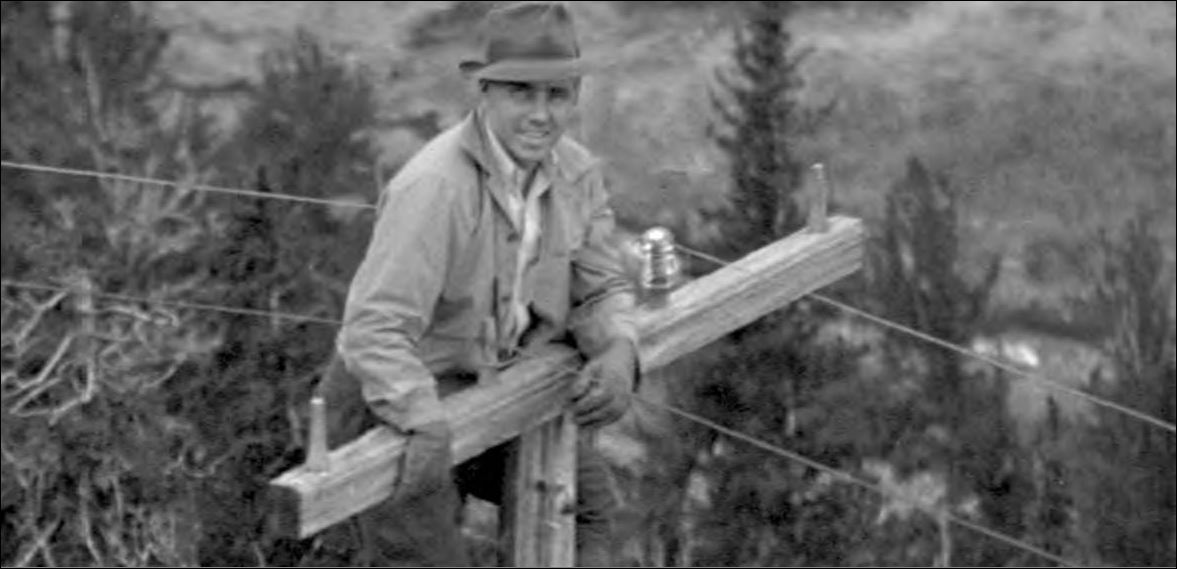 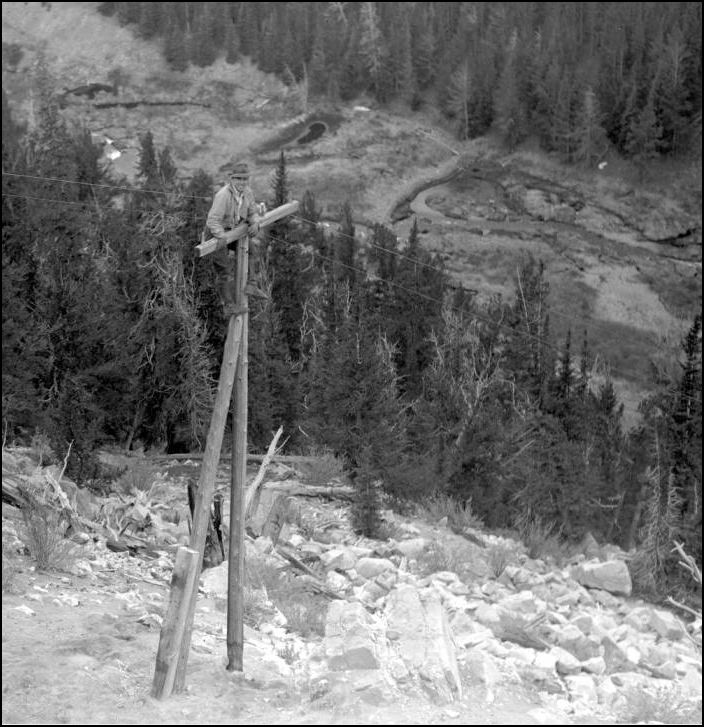 And from another angle .... http://digital.denverlibrary.org/cdm/fullbrowser/collection/p15330coll22/id/44111/rv/singleitem/rec/43 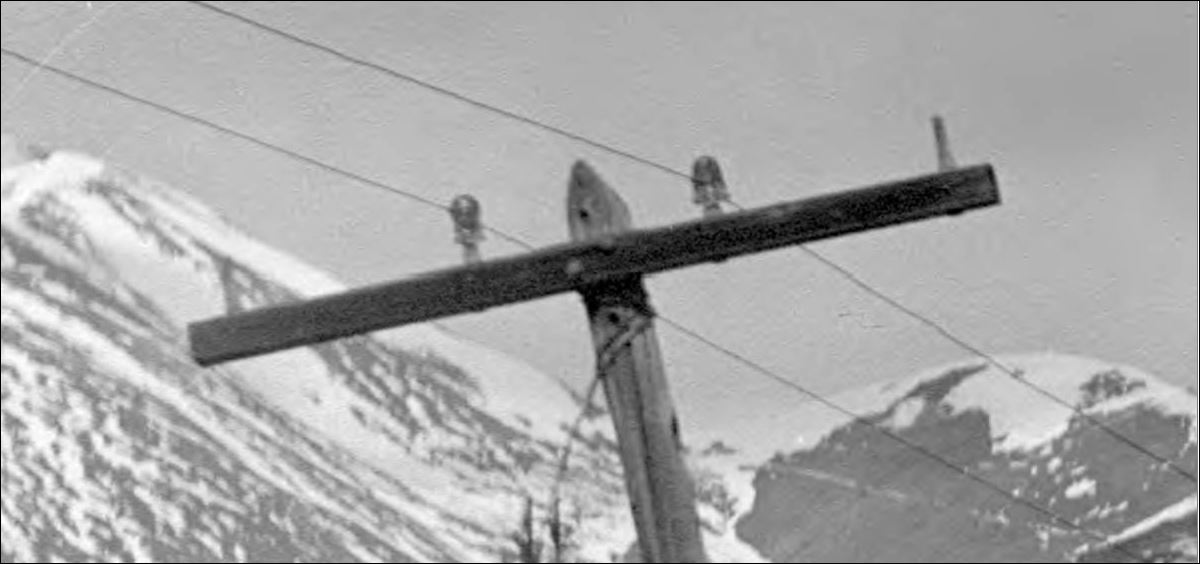 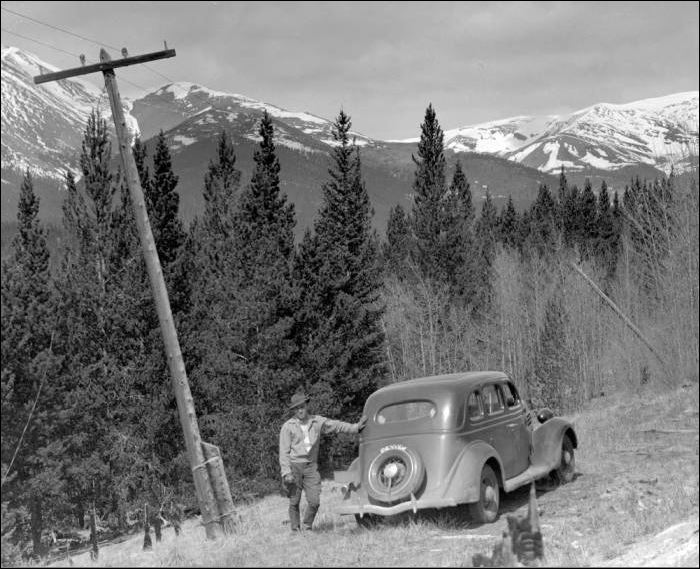
UpSideDownC
in New Zealand |
Re: Telegraph lines: Keeping It C&S.
|
That pose is the same as an earlier on by Charley Squires.
|
Re: Telegraph lines: Keeping It C&S.
|
No,not the one with the car.
|
Re: Telegraph lines: Keeping It C&S.
|
Administrator
|
In reply to this post by Chris Walker
What a great picture of Ed. He was a really nice guy. I had several very nice visits with him in the 80's. He proof read the text for "Goin' Railroading".
My Dad always carried pole climbing gear in the trunk of his car. He and I somehow put a fallen pole into a '64 Corvair and brought it back home to Boulder from along the Clear Creek Branch East of Golden. That was probably in about '65. He cut off the top 30" or so, and the ends of the cross beam so he could put appropriate insulators on it. He set it on a file cabinet in our rec room. I'm sure my long suffering mother loved it. I have that with me, stored underneath Dickey. Out of sight. My better half knew the meaning of "Nip it in the bud." But get rid of it? Really? How could I do that? |
Re: Telegraph lines: Keeping It C&S.
|
Mike,
We all make choices ....  I wear my "junk" in an in-your-face kind of way wherever I go. The women who might be interested know exactly what they are getting up front. I have found it works as a repellent for the high maintenance types I would not want in my life anyway, and attracts the good ones ... more "organic" and into simple pleasures/fun like road trips and ghost town hunting, as opposed to vacations at expensive resorts on far away islands. Since old lines and hardware were my gateway drug to old and cool, I have wired my entire property to look like an old photo that Chris Walker would post here. I keep the local building inspectors amused.  I drive a 1925 truck, and the whole place looks like you stepped through a crack in the time warp continuum and it is 1910 - 1930. All the poles (about 10) that I run wire on are done up like 1910. I have a dozen or more mock up poletops around the yard or in the shop. No hiding this stuff. You want a piece of my life, you get the whole enchilda, from USMC jargon to Victorian era stained glass. Love it or leave it ! The last time I was single, I made it a part of my evil scheme to purposely leave my wallet in the shop, forcing the prospective date into seeing what they were getting themselves into. It worked like a charm and I was able to gauge who would get a second date with ease. Been with this chick of mine for 13 years and she is as into old and cool as I am. But to be honest, this was a learned thing and earlier choices were not as well thought out !  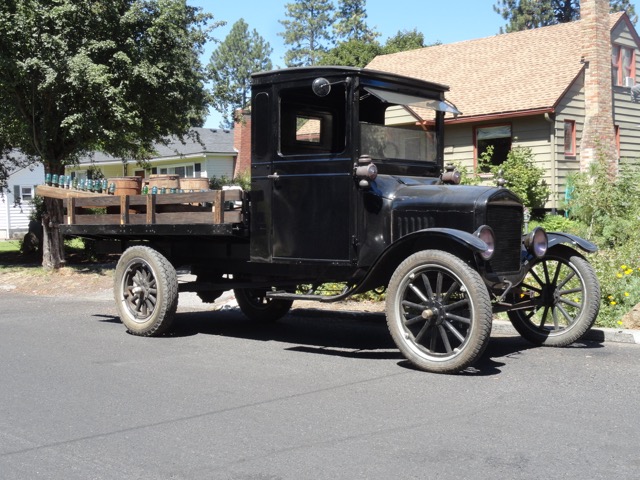 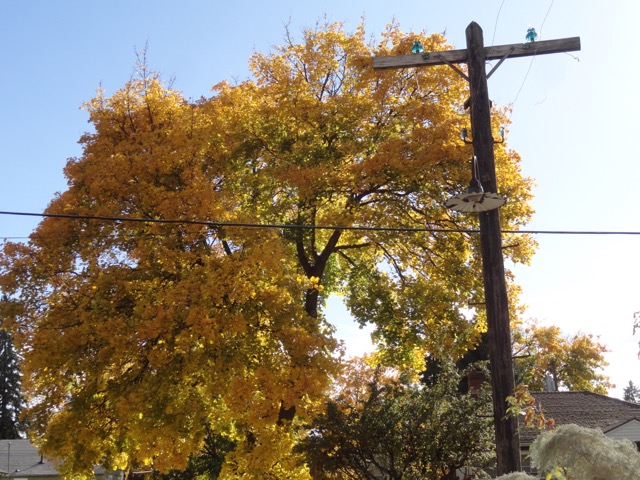 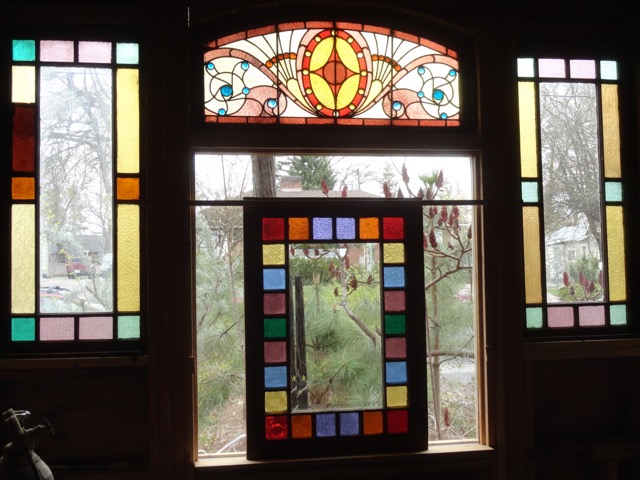
"Duty above all else except Honor"
|
Re: Telegraph lines: Keeping It C&S.
|
South Park; others- It does look as if the lines over Boreas were 6 footers. The ends of the crossarms look to be soaked with that tarry creosote I used to find on old crossarms. It is interesting to note that they left the outer pins in place, perhaps as a hedge against a broken pin or insulator. Keeping the line up in the air would have made repair much simpler! Unfortunately our lineman has positioned his arm so you cannot tell whether the pins were driven out (as spare parts?) or sawn off. I have good insulators/pins for On3, but no bare pins to install at the crossarm ends. I suppose I will figure something out. Perhaps just the stubs cut off round toothpicks. I'll post some images once I get some results. I have long believed that a diorama, module, or layout should look as good at rest as it does in action. As you are viewing your work, there should be a sense of being transported to the time/place you have modeled. And if you are not modeling a modern hump yard, there is not a lot more action than the sound of the birds, the rustling of leaves, and the sound of a train at work far down the hill. South Park, I am also an "old-fashioned" type of guy. I drive a 1979 Mercedes 240D Diesel because so many "modern" items have become "over-fangled"- that is, there has been too much nonsense added to so many products. I don't need a shop or specialist to car repairs for me. An there is just something I cannot feel confident in- new automobiles- and that something is the envelope of safety riding around in a Pepsi can with self-inflating party balloons in case of collision. Not saying there haven't been improvements- some things have been improved- but I usually search out older versions for my own peace of mind! Thanks to everyone posting to this! Stan |
Re: Telegraph lines: Keeping It C&S.
|
In reply to this post by South Park
Pictures of the Dome Rock depot show a pole with two crossarms with four wires in to the depot -on the other side there is a pole with no crossarms and one or to wires. What is the situation?
|
Re: Telegraph lines: Keeping It C&S.
|
Since SouthPark will have no idea what you're talking about.....
Photos that Robert referred to are http://digital.denverlibrary.org/cdm/fullbrowser/collection/p15330coll21/id/7116/rv/singleitem/rec/3 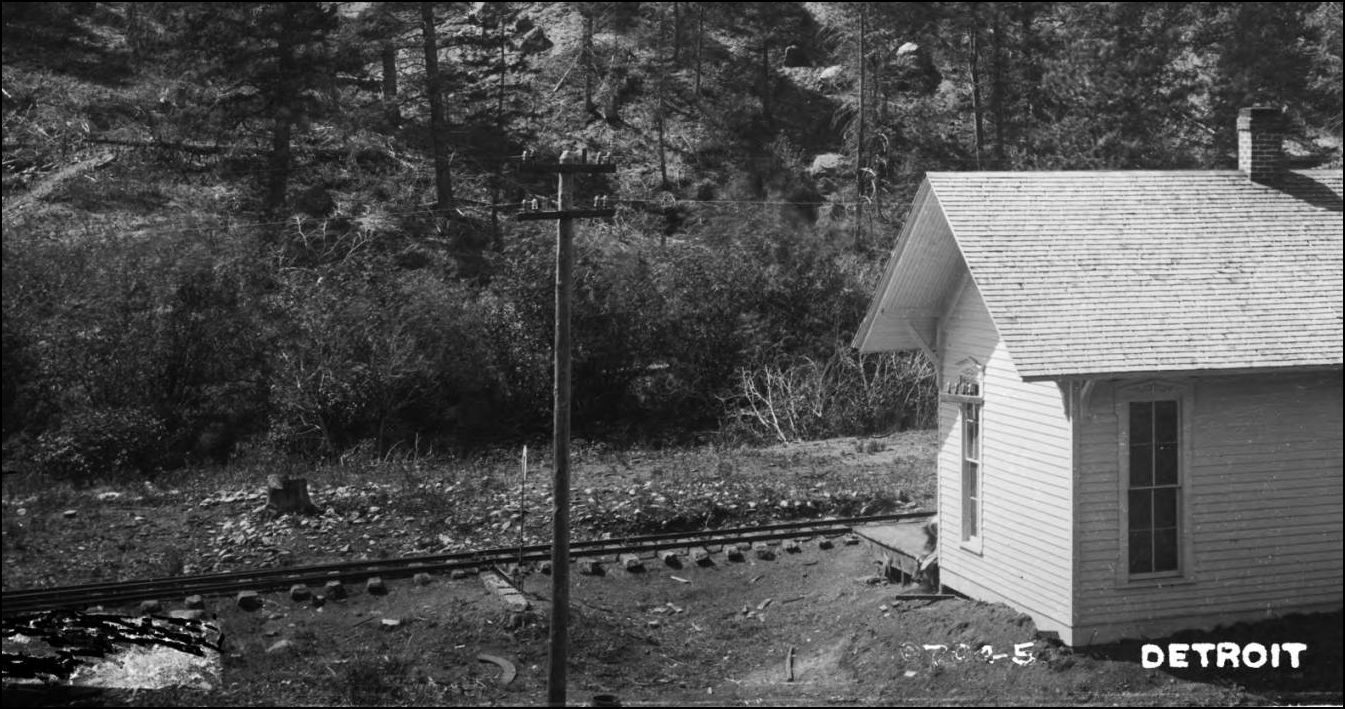 That's because there are two wires in the line, terminating at a Break on the left handside Pole, two wires going down in to the Depot and coming back out (makes four) then continuing back from the Break pole along to the next pole without crossarms, the wires insulators mounted on those angled pegs. Most Depots had a set of Crossarms at each end of the building, Jefferson is my favourite example since the Poleline upgrade changed the norm there.
UpSideDownC
in New Zealand |
Re: Telegraph lines: Keeping It C&S.
|
Note the crossarms turned parallel to the rail line. This tells the careful
observer that this is indeed a break arm pole, built to perform exactly as Chris describes. This Dome Rock photo looks to date to the early 80's, or after the UP take- -over, as there is at least one CD 126.4 on that pole, but prior to the addition of two more wires that occurred when the highline was completed. The entire line from Platte Cañon to Gunnison was built with CD 133.4 "bullets", with the 126.4's showing up as replacements in the early 80's. Here is a photo: 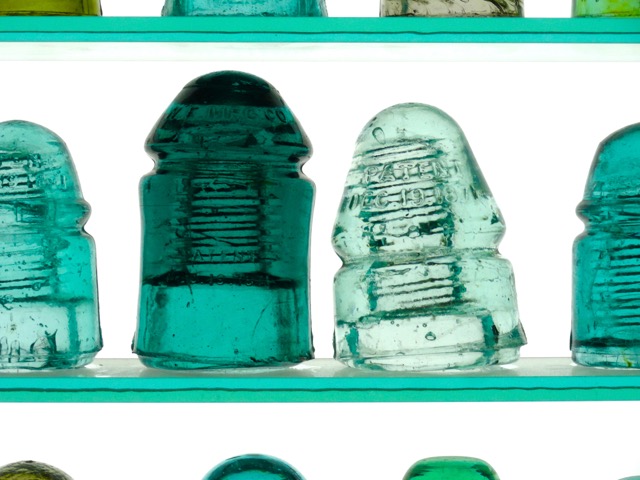 On the left is a 126.4 that was taken off the St. Elmo Depot 80 years ago. On the right is a 133.4 "bullet", found by Dennis McHenry in the rocks below the Palisades/Quartz area in the 50's. Dennis was a serious historian of this stuff, caring more about what was used where than just collecting pretty glass. Dennis purchased the other one from a local in St. Elmo about the same time. He was also the one I got my crossarms from. He said he saved them from some campers that were about to toss them on a campfire. He rounded up some other wood and traded them for the arms. Anyway .... This is exactly what I was talking about when I said early construction of the coms line was "old school" and kind of "home made". There is a great shot of the break-arm pole at Jefferson toward the end of operations that shows the modern method of using "break irons". This Dome Rock shot is a rarely seen example of how it was done before break irons became the norm. The one-sided stress of the line wire must have made for short life spans for the pins and arms and LOTS of repairs/maintenance. Note the doubled insulators and pins to fortify the dead-end strain. Just as much of the rest of the operational plant of the old South Park changed over the years, so did the coms lines. One would be remiss to go to great detail to make the rolling stock and motive power spot on perfect for an 1885 layout and string lines that would not have existed until 1920, just as one would not place 1930's automobiles in that 1885 diorama. BTW - the angled pins, nailed to the side of poles were largely referred to as "brackets" by linemen, but picked up names like "pig's ears" and "side pins/ side brackets". Photos of the stretch of line where the snow trials were held show those were used in that area.
"Duty above all else except Honor"
|
Re: Telegraph lines: Keeping It C&S.
|
Espee, I have to ask:
At Leadville there is a pole in the lot to the north of the depot. I always figured this was power, as the lines terminated on the northern dormer in front of the window. The pole and line are on my to-do list, though they will be in the way of operations, so maybe not the lines but the bracket and insulators at the window. Now I wonder if these were telegraph wires? There is a power meter on the north wall too, to the east side.
Keith Hayes
Leadville in Sn3 |
Re: Telegraph lines: Keeping It C&S.
|
Think I know what you are talking about, but can you post
a photo (or ten), so we can be sure we are playing off the same sheet of music ?
"Duty above all else except Honor"
|
Re: Telegraph lines: Keeping It C&S.
|
So, I went on the world wide web thing looking for a photo of the
C&S Leadville depot, and it seems only one end is worthy of a photo, and it is the wrong end. Pulling from memory, the crossarm in the window area is decidedly railroad/telephone type hardware, and since that kind of strike would not be used for phone on a RR building, I am confident it is the old telegraph strike/deadend. And speaking of South Park telegraph .... this gem showed up in my mail yesterday: 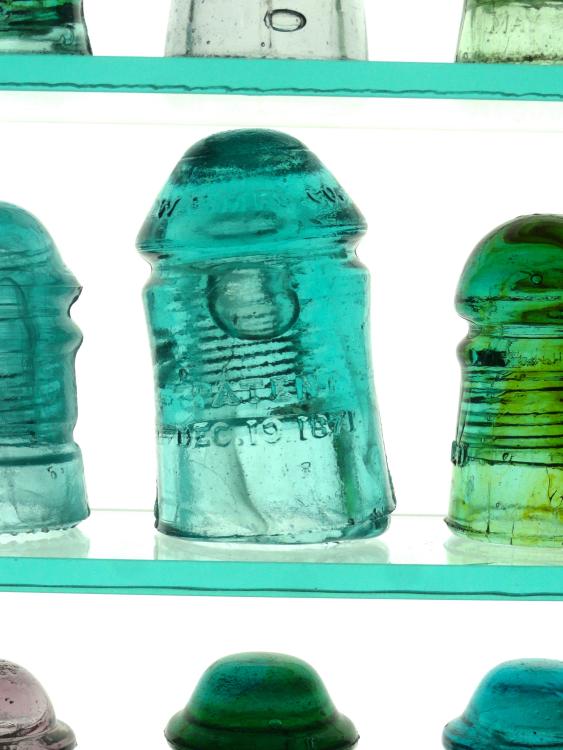 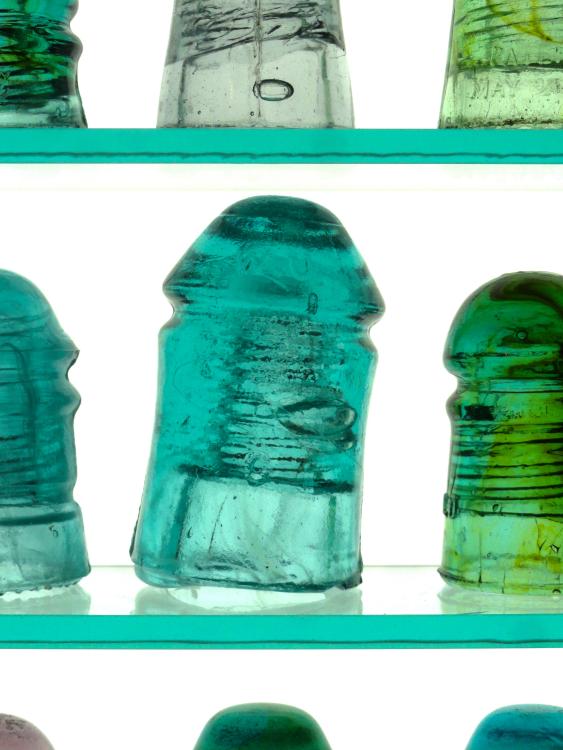 Picked somewhere "along the South Park line" by an early collector. Sadly, the specific location was not noted. Just "somewhere on the South Park". The CD 126.4 was made by Hemingray and was the first replacement style used after the original construction. This one is a pretty turquoise- aqua, and has a couple big bubbles, a healthy overpour (creating the lean) and milky impurities in the glass for added character. A similar unit is seen in the photo of Ed Haley (with the car).
"Duty above all else except Honor"
|
|
Prior to the Railroad there was a Denver to Leadville service, I seem to recollect it wentover Mosquito, presumably it came up Platte Canyon?
|
Re: Telegraph lines: Keeping It C&S.
|
I know the early line came over Kenosha and then Mosquito to get to
Leadville. Early phone line also was built over Mosquito, but I am unaware of how it arrived from the east. Poles were stupidly close, as a measure to stiffen it from the gnarly wind and snow. Insulators were Leonard Glass Co. (of Detroit) made CD 133.1's. A rubber-wrapped cable was buried over Mosquito to replace the aerial line, due to high maintenance. It too did not hold up well. Winters above timberline are killers !
"Duty above all else except Honor"
|
Re: Telegraph lines: Keeping It C&S.
|
Keith has a whole thread of pictures for you Sth'Park
Pictures are in these Posts since there are different connections for different eras :) http://c-sng-discussion-forum.41377.n7.nabble.com/Leadville-Depot-tp1936p5045.html http://c-sng-discussion-forum.41377.n7.nabble.com/Leadville-Depot-tp1936p5151.html 3rd photo in here :) http://c-sng-discussion-forum.41377.n7.nabble.com/Leadville-Depot-tp1936p5207.html http://c-sng-discussion-forum.41377.n7.nabble.com/Leadville-Depot-tp1936p6245.html and this one :) http://digital.denverlibrary.org/cdm/fullbrowser/collection/p15330coll22/id/42401/rv/singleitem 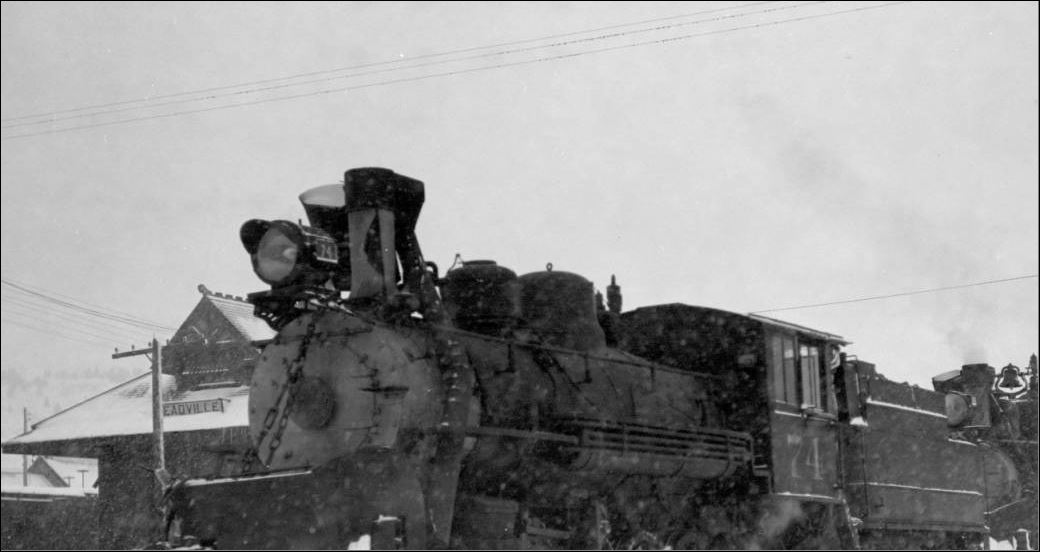
UpSideDownC
in New Zealand |
Re: Telegraph lines: Keeping It C&S.
|
Seems to me that there was a good shot of the upgrade end the
depot in Digerness' book, either volume 1 or 2 ? It showed the crossarm full of insulators. Can't remember if it was still showing wires in place ? Funny that all the pix are taken of the other end of the building.
"Duty above all else except Honor"
|
«
Return to C&Sng Discussion Forum
|
1 view|%1 views
| Free forum by Nabble | Edit this page |

